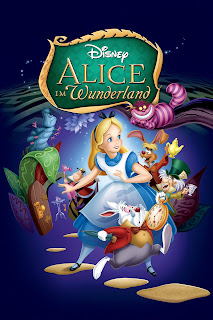DISNEY MOVIE CHALLENGE
Alice in Wonderland
WHAT IS THE DISNEY MOVIE CHALLENGE: With Disney+ making available almost all of their films from the vault I thought it was a good time to watch all the theatrically released feature length Disney Studio Animated films. That’s a lot of qualifications so what does it all mean? It must be a film developed and released under the Walt Disney Animation Studios (so no PIXAR or Tim Burton stop motion films). Must have been released in theaters (no direct to video releases). And feature length (no shorts that played prior to the features). Currently there are 58 films. Starting with Snow White and the Seven Dwarfs in 1937 going to Frozen II in 2020.
What a weird and trippy movie this is. After the huge success of Cinderella Disney released Alice in Wonderland on the world the following year. The movie failed to live up to the success as Cinderella and was one of Walt Disney's biggest disappointments. After failing at the box office he severely edited it and released it on TV for his new one hour show. The movie would not get an official theatrical re-release (as many other of Disney films did) until 1974 when it was marketed as a movie for the "psychedelic times". They even used Jefferson's Airplane song "White Rabbit" to promote the film. The movie would of course go on to be hugely popular and was one of the first Disney Films released on VHS.
Alice in Wonderland is adapted from the Lewis Carroll books Alice's Adventures in Wonderland and Alice Through the Looking Glass. Similar to the movie the first book wasn't a huge hit on initial release. The story features a young girl, Alice, who follows a White Rabbit down a hole and falls into a bizarre universe. There she meets a series of fantastical creatures including the Mad Hatter, March Hare, Cheshire Cat, a mahuker smoking caterpillar, and the Queen of Hearts. Eventually she tires of the craziness and just wants to go home, but first she goes on trial for embarrassing the Queen of Hearts who wishes to take off her head. In the end she sees herself sleeping and realizes it's all been a dream.
The story is a series of events with very little narrative driving the story. Initially it's just her search for the White Rabbit that keeps her going but then it is her desire to go home. This little thread is enough to keep the story from feeling too episodic. But the lack of narrative actually goes back to the way the book was written. Lewis Carroll helped popularize a form of literature called "Literary Nonsense". Literary Nonsense is pretty much what it sounds like. It is a story that doesn't have to follow normal rules, sometimes uses gibberish, and often defies logic. Literary Nonsense is often found in children's literature and examples can be mother goose rhymes or Dr. Seuss books. One of the most famous uses of Literary Nonsense is the poem Jabberwocky which is in the Alice in Wonderland book but was omitted from the movie (although the poem heavily influenced the 2010 Tim Burton version). The best example found in the movie is during the Mad Hatter Tea Party. There dialogue is spoken quickly and hardly ever makes sense. Another common element found in Literary Nonsense is the nonsensical riddle. The most famous being when the Mad Hatter asks Alice "Why is a raven like a writing desk?". Carroll admitted that he purposely wrote that as nonsense and there is no answer.
Since this is a children's movie I did spend some time trying to figure out what the moral of the story is. While I will probably need to watch it a few more times to really nail it down I think there is one there. Alice is constantly making bad choices and eventually she sings a song "Very Good Advice" about how she never follows the good advice she gives herself. But this actualization never seems to play a role the rest of the film and the film just ends with her waking up and we are never sure if she learned anything. Is there a lesson in the film? Let me know your thoughts.
OVERALL: Hard to describe this movie as anything other than trippy. Despite the episodic nature of the story I enjoyed it more than Pinocchio which was also episodic. I think there is just enough to feel like there is a reason for Alice to keep going, and the fantastical nature of everyone she meets makes it more interesting. I will admit that the nonsensical aspect keeps me from loving the film but there is no doubt that the Mad Hatter Tea Party scene is one of the best in the film. The fantasy aspect is fun and the characters are all memorable even if they are only in the film for a short time.
RANDOM FACTS:
Rumored to have the most characters and songs of any Disney film. Not sure if this is true but definitely could be.
The first Disney animated film to feature the voice talent in the credits.
For a majority of the film there is no villain. The Queen of Hearts becomes the villain but Alice only meets her towards the end of the movie.
One of the few Disney films that feature a female lead with no romantic interests.
The strangest theory I read about the story is that it is a metaphor for childbirth. It goes something like this. Alice travelling down the rabbit hole represents conception. Growing in a confined space represents pregnancy. Drinking potions represents the amniotic fluid. Finally escaping to explore the scary world outside on her own is childbirth.
At the time over 20 Years is the longest any Disney had gone without a theatrical rerelease.
A very trippy poster was used to promote the psychedelic aspect for the 70's rerelease. Check it out







